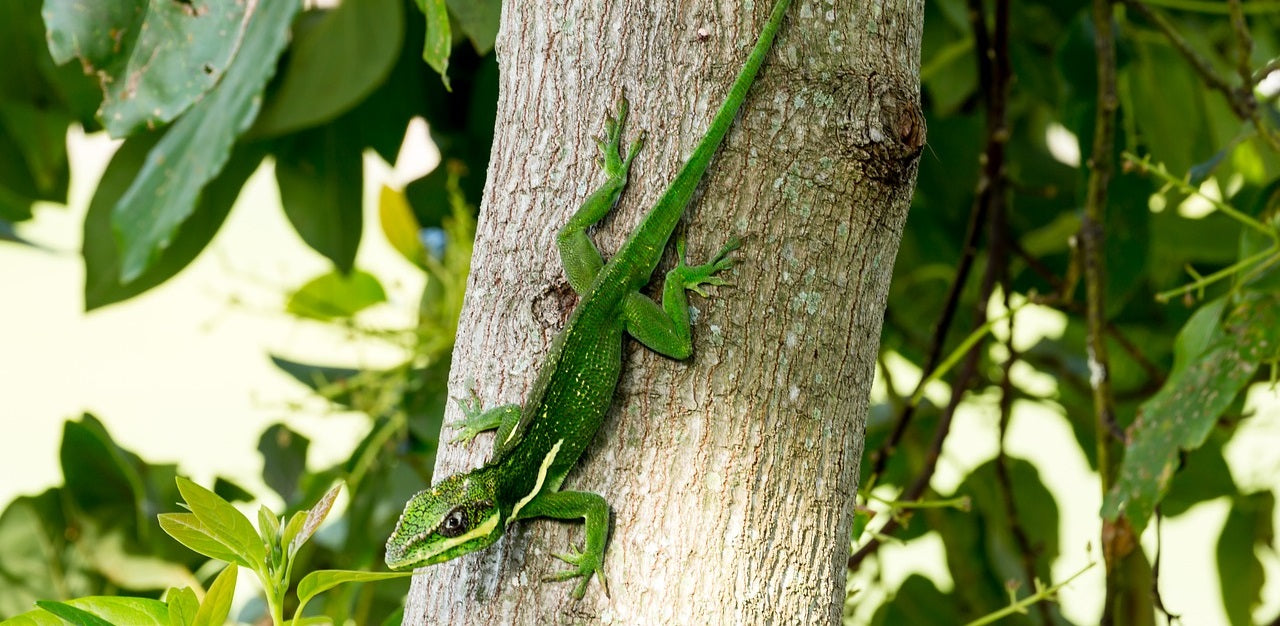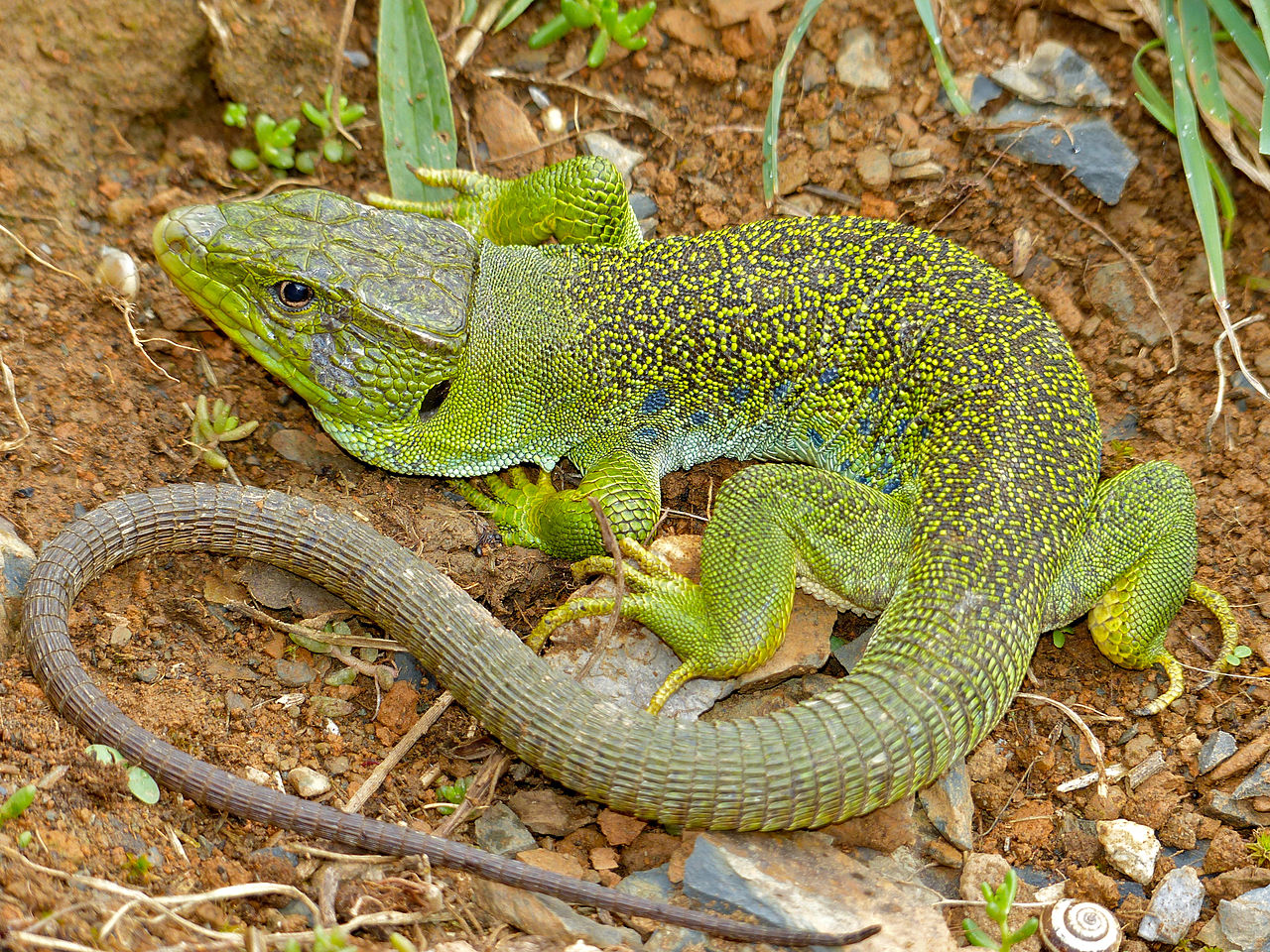Colombian tegus (Tupinambis spp.) are medium-large, diurnal lizards native to the northern half of South America. They typically prefer jungle habitats, and although they are considered terrestrial, they are also cable climbers and swimmers.
Colombian tegus typically have bronze and black coloration, with varying pattern depending on species. Compared to their Argentine cousins, they generally have more pointed heads, longer necks, and slender tails. Overall their build is similar to a juvenile Argentine tegu, with similar size at 2-3.5’ long.
Colombian tegus are often mislabeled as Argentine black and white tegus, particularly Tupinambis teguixin, the Gold Tegu. They are often wild-caught and can be highly defensive toward humans. With good care, they may live up to 10-15 years.
How much space do Colombian tegus need?
Because of their large size, a single Colombian tegu should be housed in no smaller than a 6’L x 3’W x 3’H enclosure. If at all possible, larger is recommended.This size of enclosure is not typically available for purchase, so you may need to order one custom-made or build your own.
Cohabitation (keeping multiple tegus in the same enclosure) is not recommended.
Do Colombian tegus need UVB?
UVB is required for tegus to thrive in captivity. Aside from helping provide a day/night cycle and providing an infinite supply of vitamin D, UVB is also good for the lizard’s overall health. Here are the best UVB bulbs for a Colombian tegu housed in a 6’L x 3’W x 3’H enclosure:
- Arcadia Desert 12%, 34”
- Zoo Med Reptisun T5 HO 10.0,34”
If the UVB is mounted over mesh, place the basking platform so your tegu’s back will be 13-15” below the lamp. If the UVB is mounted inside the enclosure, place the basking platform so your tegu’s back will be 17-18” below the lamp. The UVB bulb should be housed in a reflective fixture like the Arcadia ProT5 and placed on the basking side along with the heat lamp. Make sure that the fixture your UVB bulb is housed in does not have a clear plastic bulb cover.
Tegus are diurnal, which means that they are most active during the day. Make sure to provide 12 hours of light each day and turn the lights off at night.
Since tegus are active during the day, it’s beneficial to provide an additional daylight-spectrum lamp to make sure the enclosure is brightly illuminated. This is extra important since you will be using such a large enclosure. Use 4’ of strong 6500K LED or T5 HO fluorescent plant grow lights for best results.
What basking temperatures do Colombian tegus need?
Colombian tegus need a basking surface temperature of 125-135°F. Air temperature on the cool side of the enclosure can be as low as 75°F, but should be no higher than 85°F. Measure surface temperature with an infrared thermometer (“temp gun”), and air temperature with a digital thermometer placed near the basking site.
Provide heat for your lizard by imitating the sun with a cluster of halogen heat lamps placed on one side of the enclosure. You will need enough lamps to evenly heat an area at least the size of the tegu’s body. Do not use ceramic heat emitters (CHEs), heat mats, red bulbs, or blue bulbs, as these are not as effective.
Heating should be turned off at night.
What humidity levels do Colombian tegus need?
Colombian tegus need a humid environment to stay healthy. Average humidity levels should be between 70-80%. Humidity should be measured with a digital probe hygrometer with the probe in the middle of the terrarium. Daily misting with a pressure sprayer and/or using a humidifier connected to a humidistat is helpful for maintaining high humidity. It also helps to mix water directly into the substrate.
Reptile humidifiers and foggers should only be used with distilled water and require frequent disinfecting to keep your reptile from getting sick.
What substrate is good for Colombian tegus?
Using substrate in your tegu’s enclosure covers the floor, cushions your tegu’s body, helps maintain humidity, and gives the lizard something to dig around in. We recommend the following substrates for tegus:
Layering clean, chemical-free leaf litter on top of the substrate can help with humidity as well as add enrichment value.
Substrate should be at least 6” deep and completely replaced every 3-4 months. Remove poop and urates daily, along with any contaminated substrate.
What décor can you use in a Colombian tegu enclosure?
Colombian tegus are active and curious, so it’s terribly boring for them to be stuck in an enclosure with nothing in it except a water bowl and hideout. It doesn’t matter how big the enclosure is if you don’t put things in it for your pet to use and interact with.
Here are some ideas:
- climbing branches
- hollow logs
- tree stumps
- additional hiding places (dog/cat kennels can work well)
- live or artificial foliage
What do Colombian tegus eat?
Colombian tegus are carnivores, which means that they need a diet of mostly animal-based foods in order to get the nutrition that their bodies need. However, they do need about 10% of their diet to come from fruits and vegetables. How often they need to eat depends on age:
- Hatchlings (0-6 months) — 5x/week
- Juveniles (7-12 months) — 4x/week
- Subadults (1-2 years) — 3x/week
- Adults (>2 years) — 2x/week
Protein options for Colombian tegus: crickets, dubia roaches, red runner roaches, black soldier fly larvae, mealworms, superworms, darkling beetles, hornworms, silkworms, snails, grasshoppers, chicks, quail chicks, egg (with shell), mice, rats, gerbils, small rabbits, shrimp, salmon, high-quality canned dog food
Vegetable options for Colombian tegus: collard greens, cactus pads, spring mix, arugula, kale, pea shoots, alfalfa, bok choy, carrot greens and roots, spinach, dandelion greens/flowers, hibiscus leaves/flowers
Fruit options for Colombian tegus: berries, figs, apples, prickly pear, papaya, mango
Remember — the key to providing a healthy diet for your Colombian tegu is VARIETY!
Supplements
You will also need calcium and vitamin supplements to prevent your lizard from developing a deficiency. We recommend Repashy Calcium Plus LoD, lightly dusted on all foods (excluding whole vertebrate prey and dog food).
Water
You will also need a water bowl. Since Colombian tegus are big and like to soak or even swim, you will need to use a tub at least large enough for your tegu to fit in. Change the water at least twice a week and scrub the bowl with a reptile-safe disinfectant weekly, or whenever it becomes soiled.
Do Colombian tegus like to be handled?
Colombian tegus are well-known for being defensive and difficult to tame. Work on building a trusting relationship with your tegu so it will let you pet it and pick it up when needed. Offering food from feeding tweezers works well as an initial bribe, and it’s best to get the lizard to come to you rather than simply grabbing it — a bite from a startled or defensive adult tegu is no small thing!
If you have to pick up your Colombian tegu, don’t grab the lizard from above — instead, approach from the side and scoop from below. Support as much of its body as possible, especially its feet. When possible, let it climb onto your arm rather than picking it up. Start with very short handling sessions in the beginning, then gradually make them longer as your pet becomes more accustomed to you.
*This care sheet contains only very basic information. Although it’s a good introduction, please do further research with high-quality sources to obtain additional information on caring for this species. We recommend the following sources:
Image by Joel santana Joelfotos from Pixabay




Leave a comment
This site is protected by hCaptcha and the hCaptcha Privacy Policy and Terms of Service apply.